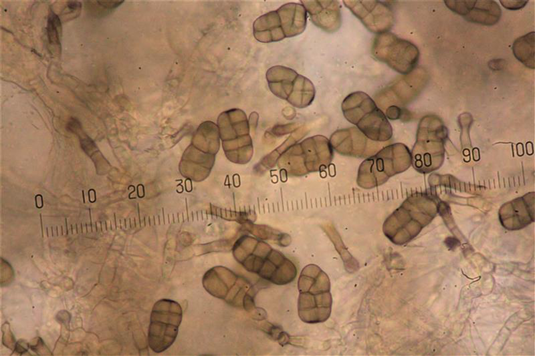
Features
Research
Harnessing the microbial masses
July 12, 2023 By Tim Morcom, Perennia vegetable specialist
 Microbes plated and viewed under a microscope. Photo courtesy of Dustin MacLean.
Microbes plated and viewed under a microscope. Photo courtesy of Dustin MacLean. Recent research on plant-microbe interactions offers fascinating new insights with great potential to grow crops less stressed by abiotic factors – and to grow them with less expense and of greater quality while maintaining or increasing soil organic matter.
Microbes and plants have co-evolved since at least the point where plants made their leap from the oceans to land. Researchers have even suggested that the only way plants could make that leap is through the horizontal gene transfer of environmental tolerance genes from bacteria to plants. From that point on (and likely long before), plants and microbes have been involved in both a synergistic and antagonistic dance. For farmers, producers and extension specialists, microbes are a crucial part of a crop’s success. To look only at the plant’s needs is to see just half the story and create unnecessary labour and expenses by attempting to supply the benefits microbes intrinsically provide.
Microbes are the driving force behind soil organic matter (SOM) creation, and their growth is generally carbon-limited. We can create habitats that foster beneficial microbes by providing carbon sources to the soil through cover crops (biomass as well as root exudates) and applications of non-labile carbon sources. Microbes, in turn, will mineralize nutrients to plants and create stable mineral-associated organic matter. Microbial necromass (i.e. dead plant matter, dung or carrion) can make up more than 50 per cent of soil organic carbon, generally in a much more stable form than the particulate organic matter that is generated from macro residues such as incorporated biomass. This soil organic matter-generating process is so powerful that, with only the addition of complex sugars over 18 months, researchers at the University of New Hampshire were able to transform sterile clay powders into a stable soil-like aggregate with SOM levels the authors suggest are similar to real-world soils. Plants do this constantly through root exudates and can even change the composition of the exudates they supply to the soil based on the microbial populations they want to promote.
Root exudates are powerful tools plants use not only to assist in the generation of soil organic matter, but also in harvesting nutrients from the soil through the rhizophagy cycle (a process by which symbiotic microbes alternate between an intracellular/endophytic phase and a free-living soil phase). Through this cycle, plants can create “hotspots” of microbial activity with root exudates tailored towards promoting specific microbial populations that will accomplish specific tasks within the soil. Flavonoids, for example, are used as signalling molecules by legumes to associate with rhizobia species as well as mycorrhizal fungi. Plants can induce rapid mineral-associated organic matter mineralization by releasing acids, like oxalic acid, within root exudates. This process has also been proposed as a method through which non-nitrogen fixing plants can liberate bioavailable nitrogen resources. A recent study by a team of researchers at Rutgers University in New Jersey showed that bacteria on grass seedlings resulted in 30 per cent more nitrogen acquisition by those seedlings than by seedlings without associated bacteria.
Throughout a plant’s life, symbiotic microbes directly influence plant growth and resistance to phytopathogens through the synthesis of phytohormones, antibiotics, nitrogen fixation, rhizomediation and the mineralization of nutrients within the soil. These influences can go as far as reducing foliar feeding by insects and herbivores. It’s amazing to think that underground microbial populations can significantly affect insect pests’ power to defoliate your crop.
Producers can promote greater soil microbial diversity and begin to harness some of these benefits through “microbe-friendly” practices, such as:
- Minimizing soil disturbance to maintain fungal hyphae;
- Always keeping root exudates pumping into the soil through a diverse cover crop when not cash-cropping, or intercrop cover crops into your cash crop;
- Not exceeding your crop’s nutrient requirements when fertilizing; and
- Incorporating microbe-rich amendments into your system, such as composts or manure.
Much of this research, and our understanding of plant-microbe interactions, is in its infancy. It could signal a new, exciting era of agriculture, one where microbes play a central role in reinvigorating and maintaining soil health for generations to come.
Print this page